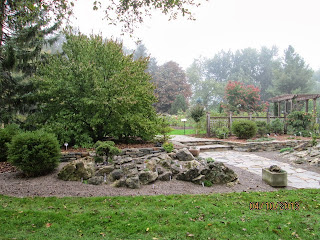Mary-Jane DeJonge, Dylan Mcleod, Kayla Teves
November 1-3, 2013
Friday November 1st 2013
Today we all met downtown London for our practical at the
corner of York and Richmond. We were installing a green roof for Youth
Opportunities Unlimited (Y.O.U.). We began our day with a safety briefing
inside the Cornerstone building café. We were then split into three groups to
make the work more efficient. Every hour we rotated potions so that everyone may
have the opportunity to be involved in the whole project. While one group
carried the materials up the stairs and elevators another group prepared the
site by cutting and measuring materials. While all this was being done the
third group was in charge of installing and constructing the site. After lunch
we were instructed to drive to veteran’s memorial (London Life Location) to
correct repair and re tie all improperly staked trees. There were more
improperly staked trees than expected so by the time we were finished it was
time to go home.
Saturday November 2nd 2013
It was a cold, blustery, rainy day at the A.M Cuddy Gardens.
We began our day by raking and collecting all the fallen apples and leaves off
the flagstone pathway, located underneath the apple tree. From there, we
started to prepare a garden bed for transplanting; we cultivated, weeded, and
raked away debris. The plants that we dived and transplanted into their new
home were called Geum triflorum, and Epimedium. We were given free rein to
create the pattern in which they’d be laid out. As our creative juices started
flowing, together we came up with a beautifully laid out design that takes the
viewer’s breath away! Next, we planted a Spirea shrub as well as two Hypericums
near the iris garden. From there, we continued dividing the Epimedium plants in
order to fill in voids in the existing bed. We concluded our day by cleaning
and putting away our garden tools and locked up for the evening.
Sunday November 3rd 2013
With sunshine on the forecast, we were ready to begin work!
We began our day by completing the Epimedium garden bed. We finished dividing
all the plants, and then transplanted them in a nice sequence throughout the
bed. This took up majority of our morning. After lunch, we did a lot of fall
cleanup. We cleaned out the rock garden of debris, leaves in various places
around the grounds, as well as blew off all pathways on the property with the leaf
blower. We were also instructed to tidy up all the walnuts that had fallen off
the tree. Lastly, we took down the curtains that were left behind from the CLT
testing and tidied and put away all of our tools. It’s now home time, goodbye.
Plant
Profile: Asimina triloba (Common Pawpaw or
Custard Apple)
Botanical Information:
Family: Annonaceae
Genus: AsiminaSpecies: triloba
Type: Woody Deciduous shrub or small tree
Height: 12m
Spread: 5m





































